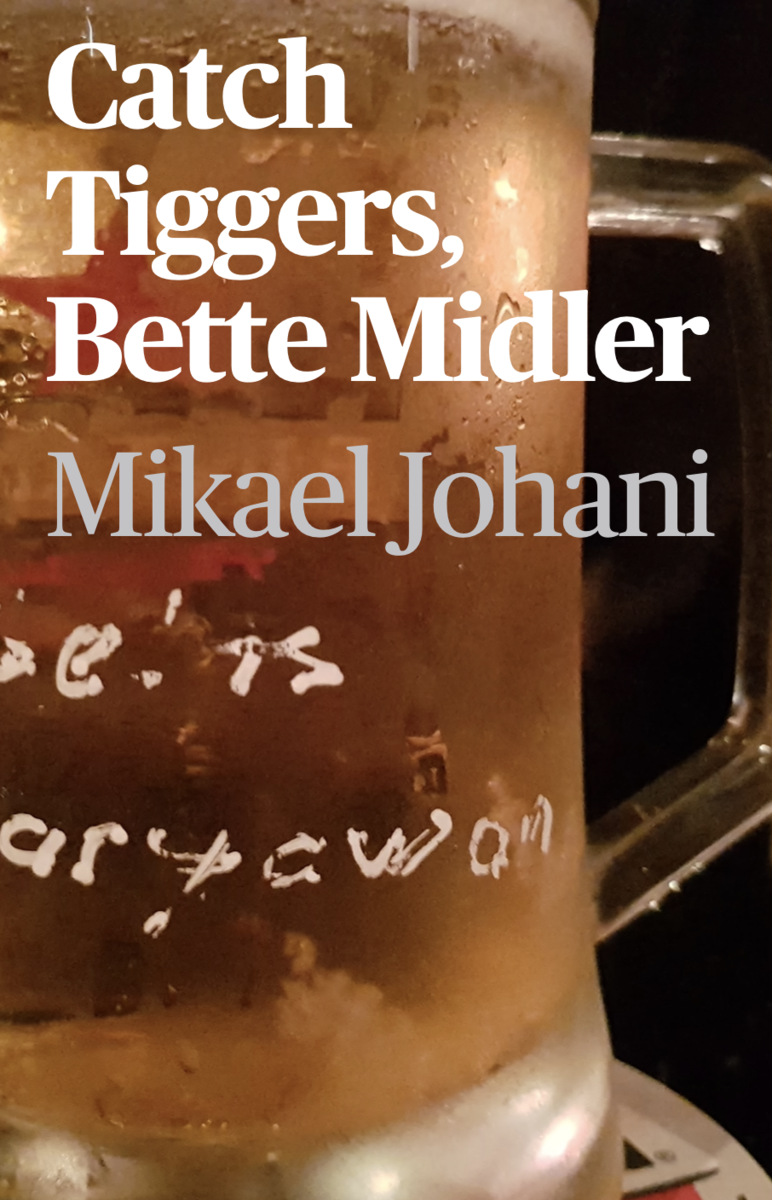review of Mikael Johani’s new chapbook Catch Tiggers, Bette Midler by Jessica Ginting. download a copy for free here.
“so tell me, what are you?
so am i robot, not a human, too?”
- [In Which No Pun]
There’s an urgent sense of unraveling in the poems within Mikael Johani’s Catch Tiggers, Bette Midler. Like forgetting what you’ve packed in your bag and watching the contents spill out as you’re walking down the street. These poems are part-continental mystery, part-introspective conversations (with who? you’ll find out, or perhaps not) that carries the reader through cities, stories, conversations.
There is no stable ground. There are revelations and non-revelations. In ‘In Which No Pun’, the speaker demands answers out of everything: gum trees, for answers on a missing acquaintance, shoes, for the perfect escape, levis, for answers on women, finally asking:
“so tell me, crisp, perfect biscotti why in the dawn of someone’s life, dreams of faulchion and perfect shields of gold, of ambrosia and foxy iris bold, still
can’t convince me that life will be any thing but just so
so?”
The code-switching employed makes for a very avant-garde, almost maximalist experience of language in these poems. The fact that there are so many references one would be bound to miss—including myself—creates the feeling that you’re being thrust on a rollercoaster of sensory experiences all at once. But even for a collection so focused on precise imagery, the characters inside wave it off, acknowledging that things always one letter away from becoming something else:
“the last time mike d. saw rob g. was at an indian restaurant called passage to india. it was missing the ‘the’ or the ‘a’, he cannot quite remember. words are just dead neons anyway, ha.”
- [In Which The End]
Still on the subject of the scattered references; I think, similarly to the way language is employed, there’s an earnest message in there somewhere about the obfuscation of idealized capitalistic travel aesthetics, even through the romanticization of food via-cultural-historical-travel routes:
“rob g. explained everything to mike d. he knew so much about the world, he looked into everything lovingly.
they ordered a thali, a dosa, and a dessert called jamun, or gulab, or jamun gulab, whichever way they called it the only thing they remember was the sauce that the chef said came from a special
breed of honey”
- [In Which The End]
This could be me projecting, but growing up in Jakarta, it took me a long time to realize how strange our jumbled collage of cultural touchpoints can often be. Often using things or images as shorthand to bigger ideas or socioeconomic values (like, say, the origins of a specialist desert) without fully diving into what they mean, you start building an identity around various forms of shorthand. Eventually, the shorthand becomes the building blocks of a language of your own.
Against some of the more intimate poems, this obfuscation of imagery starts to make a little bit more sense, often as barriers between intimacy, “when I asked you to please, pay attention to my whining / like wearing Swear London in a sea of Trippens” or even as moments most grounded in reality, “a stale baguette poking out of your Céline calfskin make a dress out of your shower curtains i can now see your pubic hair / my favourite red pubic hair / the colour of rotten tangerines” [In Which (Your) Cheatin’ Art].
The bare aesthetics and the references used hit differently here. They feel shallow, empty. Comitragic, even. I was impressed by the flexibility at which Mikael manages to manipulate and contort these layered and conflicting emotions in a burst of words:
“okay then, i should be off, searching for my imaginary lighter in the coin slots of your car. there was awkwardness, but we were chatting again on the dyke a couple of weeks later. all’s well that ends. swell.”
- [In Which Tee-vas]
The use of lenses in poetry is something that I like paying attention to, and I love the lens that Mikael has chosen to look through in Catch Tiggers, Bette Midler. It’s happy/sad. It’s colourful in the way washed out paint dropped on the streets are. You don’t quite know what happened back there, but you want to keep following the trail to see it through to the end. Again, the use of language is certainly the highlight in this collection. I think poetry is the most interesting when you can tell that the author has built a language of their own, and Mikael certainly has.
It’s the type of book that’s going to make me think twice the next time I look at something to try to play a game of identification with it. It makes me want to ask: who are you, why are you like this, do you have the answers to the most specific questions in my interior? (I will pass judgement, either way.)
Jessica Jemalem Ginting’s chapbook Voyages available from Bottlecap Press.
